Summary
In December 2022, Rethink Priorities, in collaboration with CEA, surveyed the EA community[1][2] in order to gather “perspectives on how the FTX crisis has impacted the community’s views of the effective altruism movement, its organizations, and leaders.”
Our results found that the FTX crisis had decreased satisfaction with the EA community, and around half of respondents reported that the FTX crisis had given them concerns with EA meta organizations, the EA community and its norms, and the leaders of EA meta organizations.
Nevertheless, there were some encouraging results. The reduction in satisfaction with the community was significant, but small, and overall average community sentiment is still positive. In addition, respondents tended to agree that the EA community had responded well to the crisis, although roughly a third of respondents neither agreed nor disagreed with this. Majorities of respondents reported continuing to trust EA organizations, though over 30% reported they had substantially lost trust in EA public figures or leadership.
Respondents were more split in their views about how the EA community should respond. Respondents leaned slightly towards agreeing that the EA community should spend significant time reflecting and responding to this crisis, at the cost of spending less time on our other priorities, but slightly towards disagreement that the EA community should look very different as a result of this crisis.
EA satisfaction
Recalled satisfaction
Respondents were asked about their current satisfaction with the EA community (after the FTX crisis) and to recall their satisfaction with the EA community at the start of November 2022, prior to the FTX crisis.
Satisfaction with the EA community appears to be half a point (0.54) lower post-FTX compared to pre-FTX.
Note that the median satisfaction scores are somewhat higher, but similarly showing a decrease (8 pre-FTX, 7 post-FTX).
Satisfaction over time
As the 2022 EA Survey was launched before the FTX crisis, we could assess how satisfaction with the EA community changed over time. We fit a generalized additive model in which we regressed the satisfaction ratings on the day the survey was taken.
These results show that satisfaction went down after the FTX crisis first started.
It should be noted however that this pattern of results could also be confounded by different groups of respondents taking the survey at different times. For example, we know that more engaged respondents tend to take the EAS earlier.
We therefore also looked at how the satisfaction changed over time for different engagement levels. This shows that the satisfaction levels went down over time, regardless of engagement level.
Concerns
Respondents were asked whether the FTX crisis has given them concerns with:
- Effective Altruism Meta Organizations (e.g., Centre for Effective Altruism, Open Philanthropy, 80,000 hours, etc.)
- Leaders of Effective Altruism Meta Organizations (e.g., Centre for Effective Altruism, Open Philanthropy, 80,000 hours, etc.)
- The Effective Altruism Community & Norms
- Effective Altruism Principles or Philosophy
Majorities of respondents reported agreement that the crisis had given them concerns with EA meta organizations (58%), the EA community and its norms (55%), just under half reported it giving them concerns about the leaders of EA meta organizations (48%).
In contrast, only 25% agreed that the crisis had given them concerns about EA principles or philosophy, compared to 66% disagreeing. We think this suggests a somewhat reassuring picture where, though respondents may have concerns about the EA community in its current form, the FTX crisis has largely not caused respondents to become disillusioned with EA philosophy or principles.
Other responses
Respondents were also asked to indicate their agreement with the following statements:
- I expect the FTX crisis will substantially harm my mental health in the long term.
- The FTX crisis has substantially harmed my mental health in the short term.
- I am less likely to associate myself with Effective Altruism publicly as a result of the FTX crisis.
- I want the EA community to look very different as a result of this crisis.
- The EA Community should spend significant time reflecting and responding to this crisis, at the cost of spending less time on our other priorities.
- The EA community has responded well to the FTX crisis so far.
Perhaps most reassuringly, more respondents agreed that the EA community had responded well to the crisis so far (47%) than disagreed (21%). That said, around a third of respondents neither agreed nor disagreed with this statement, perhaps due to ambivalence or uncertainty.
However, a plurality of respondents also agreed that the EA community should spend significant time reflecting and responding to this crisis, at the cost of spending less time on our other priorities (47%), compared to 37% disagreeing. Likewise, 39% agreed that they wanted the EA community to look very different as a result of this crisis, while 42% disagreed.
In addition, a sizable minority (38%) reported that they were less likely to associate with EA due to this crisis. But very small percentages agreed that the crisis would substantially harm their mental health in the short (13%) or long term (4%).
The results are shown below (percentages smaller than 5% are not labeled).
Trust in EA organizations
Respondents were asked how much they trust OP, 80K, and CEA. The results are presented below. Categories smaller than 2% are unlabelled.
Large majorities reported tending to trust each organization. However, levels of distrust were higher for CEA compared to 80K and OP. Comparing the average levels of trust between the organizations we see that trust in OP is highest, followed by 80K, followed by CEA.
Trust in EA public figures or leadership
Respondents were asked whether they had lost substantial trust in EA public figures or leadership (excluding FTX and Alameda employees). The majority of respondents said they had not, although a substantial portion of the respondents (31%) said that they did.
What actions would respondents like to see in the next few months?
Responses from respondents were classified into recurring themes. Each individual response could be coded as mentioning multiple themes at once.
Below we show a table with the counts for each category and the percentage of respondents who answered this question (n=411) who mentioned each type of action. It’s important to note that since this only shows whether respondents mentioned an action spontaneously as something they would like to see, the levels of support for some actions may be much higher.
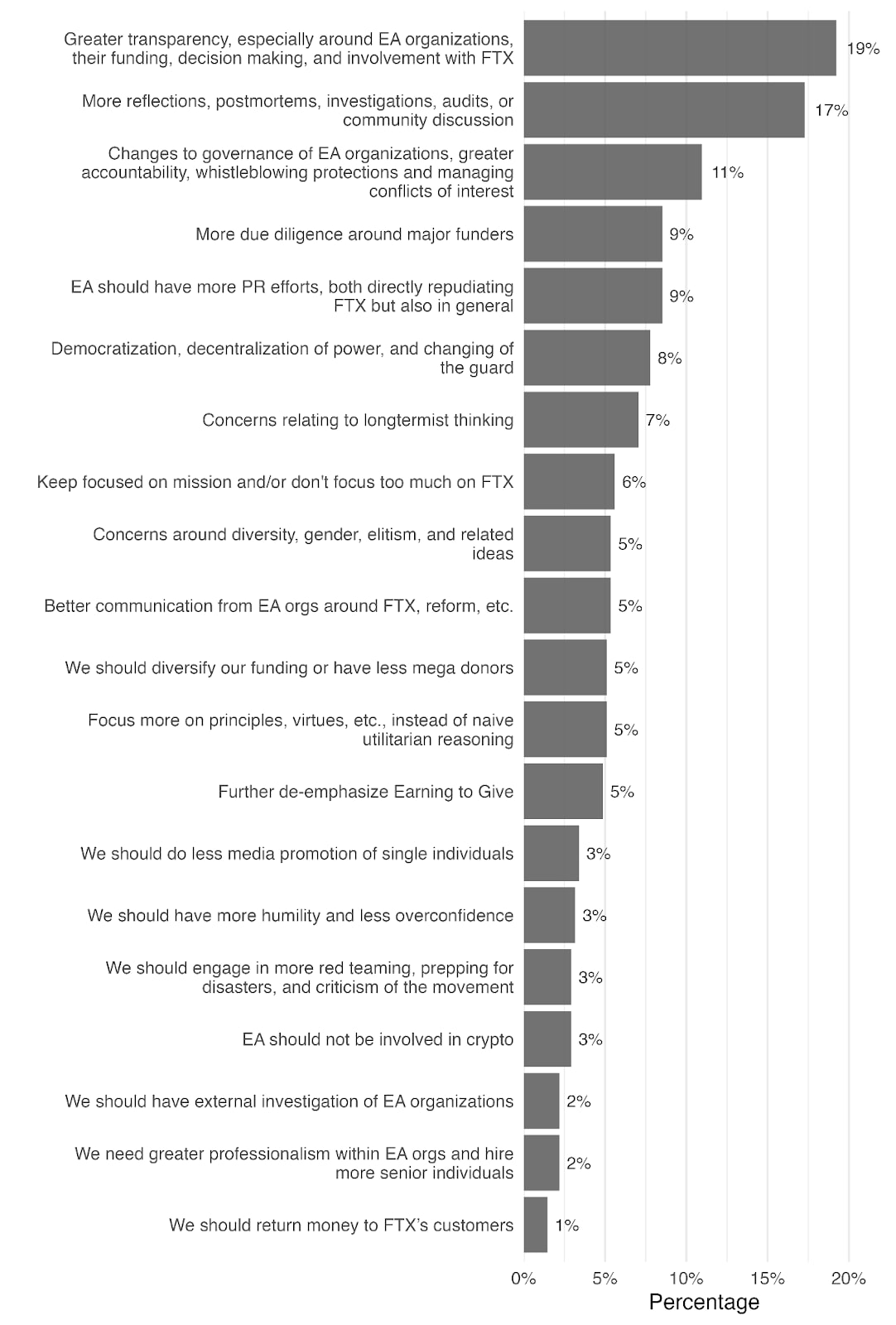
Differences between groups
We also examined whether responses differed across different groups within the EA community.
Across different questions, we found some recurring patterns:
- We found a number of differences between men and non-men respondents, including non-men respondents expressing more concern, being more inclined to agree the community should look significantly different as a result of the crisis, and less likely to agree that the community had responded well to the crisis.
- A similar pattern was observed in terms of cause prioritization, with higher support for longtermism being associated with expressing less concern, being more likely to agree that EA responded well to the crisis and less likely to think the EA community should look very different. Longtermists also expressed higher trust for core EA meta orgs.
- The most highly engaged respondents were more likely to express concerns as a result of the crisis (except regarding EA philosophy). They were also more likely to report their mental health had been affected. And they reported lower trust in CEA (though higher trust in OP). However, they seemed slightly less likely to report that the EA community should look very different as a result of this crisis.
Satisfaction
While we found a number of differences in satisfaction with EA (both pre- and post-FTX) across different groups-as we have in previous years-we did not find any significant interaction between these groups and change in satisfaction towards EA. For example, we found that men reported higher satisfaction with EA than non-men[3] respondents, on average, but we observed a similar decrease in satisfaction across both groups post-FTX.
Concerns
Cause prioritization
We observed differences depending on the extent to which the respondent prioritizes neartermist[4] (global poverty and mental health) and longtermist causes (biosecurity, nuclear security, AI risk, existential risks). Those who prioritize longtermist causes more reported being less concerned across all concern questions while those who prioritize neartermist causes more reported being more concerned across all questions.
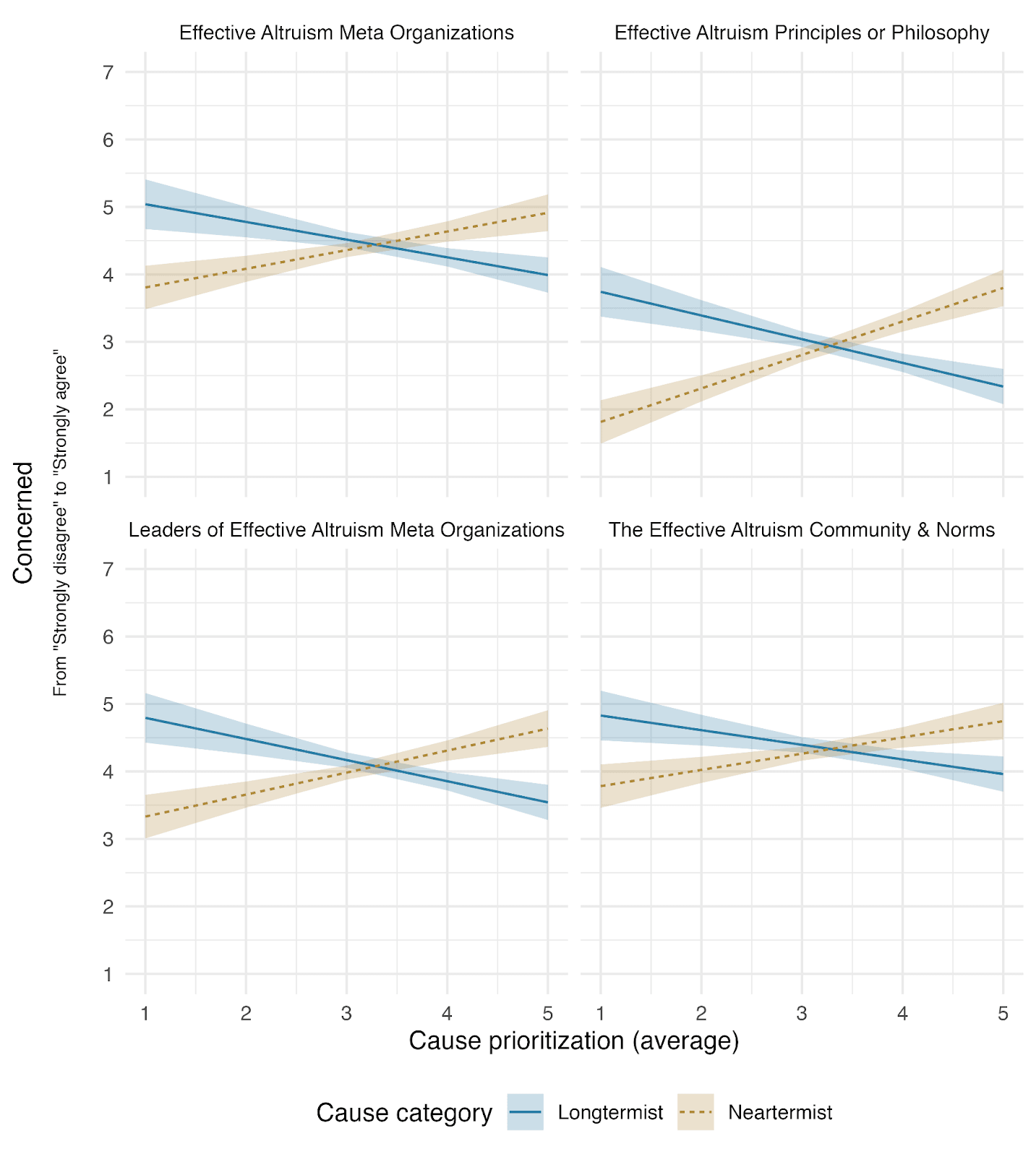
Engagement
Additionally, we observed some diverging patterns involving EA engagement. More engaged respondents were less concerned about EA principles or philosophy, but more concerned about EA meta organizations and its leaders. No statistically significant differences were found regarding concerns about the EA community and norms.
Gender
There were several gender differences. Men were less concerned about EA principles or philosophy than women, non-binary respondents, and those who preferred to self-describe (combined into ‘Non-men’[3]). Men were also less concerned about the EA community and norms. There were no significant gender differences for the other two concerns.
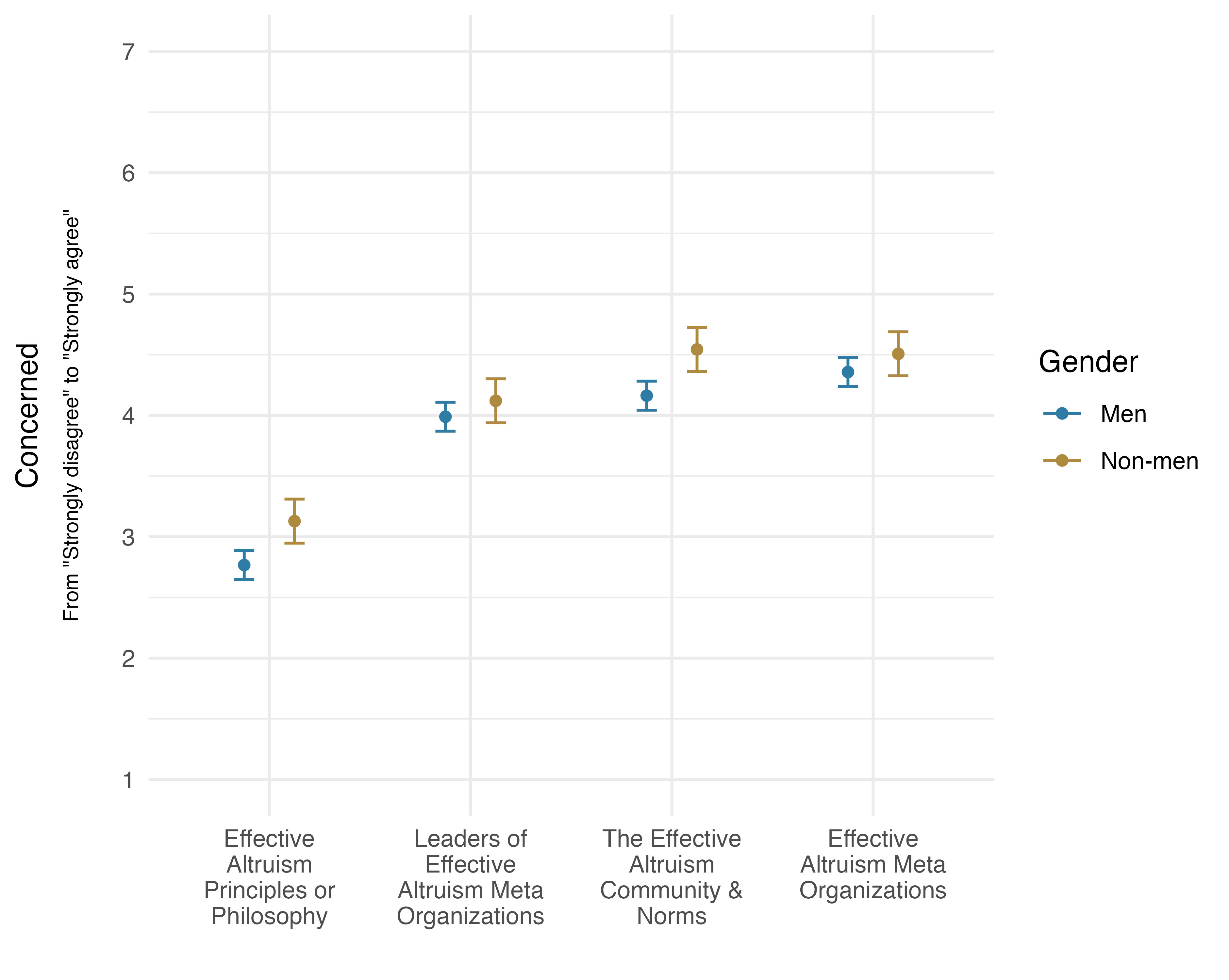
Age
The respondent’s age was also found to relate to several of the concerns, although these relationships were very small. There was a small negative correlation with concerns about the EA community and norms (r = -.07) and leaders of EA meta organizations (r = -.06).
Race
Finally, we also observed a difference between white respondents and non-white respondents on one of the items[5]. Non-white respondents seem to be slightly more concerned about meta-organizations than white respondents are.
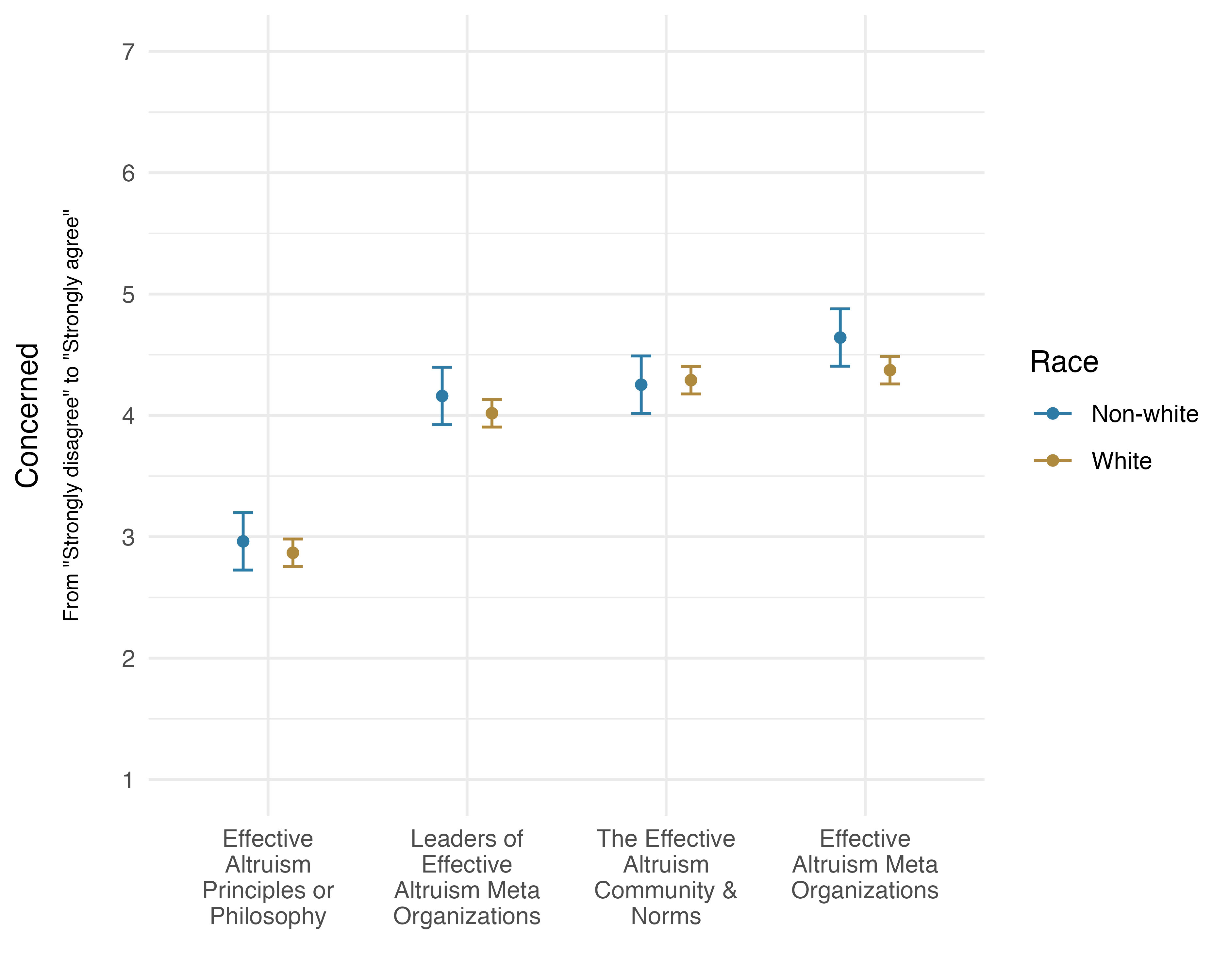
Other responses
Cause prioritization
There were several different patterns depending on the cause prioritization of the respondent. We observed that the more the respondent prioritizes neartermist causes, the more they agreed that EA should reflect and respond to this crisis, that the EA community should look very different, and that they are less likely to associate with EA. They agreed less with EA responding well to the FTX crisis so far and the FTX crisis harming their mental health (but no relationship with mental health in the longterm).
Opposite patterns were observed when the respondent prioritizes longtermist causes more. The more they prioritize longtermist causes, the more they agreed that EA responded well to the crisis so far and that FTX harmed their mental health (short term). They agreed less with wanting the EA community to look very different and to being less likely to associate with EA. No relationship was found for FTX harming their mental health in the long term and that EA should reflect and respond to this crisis.
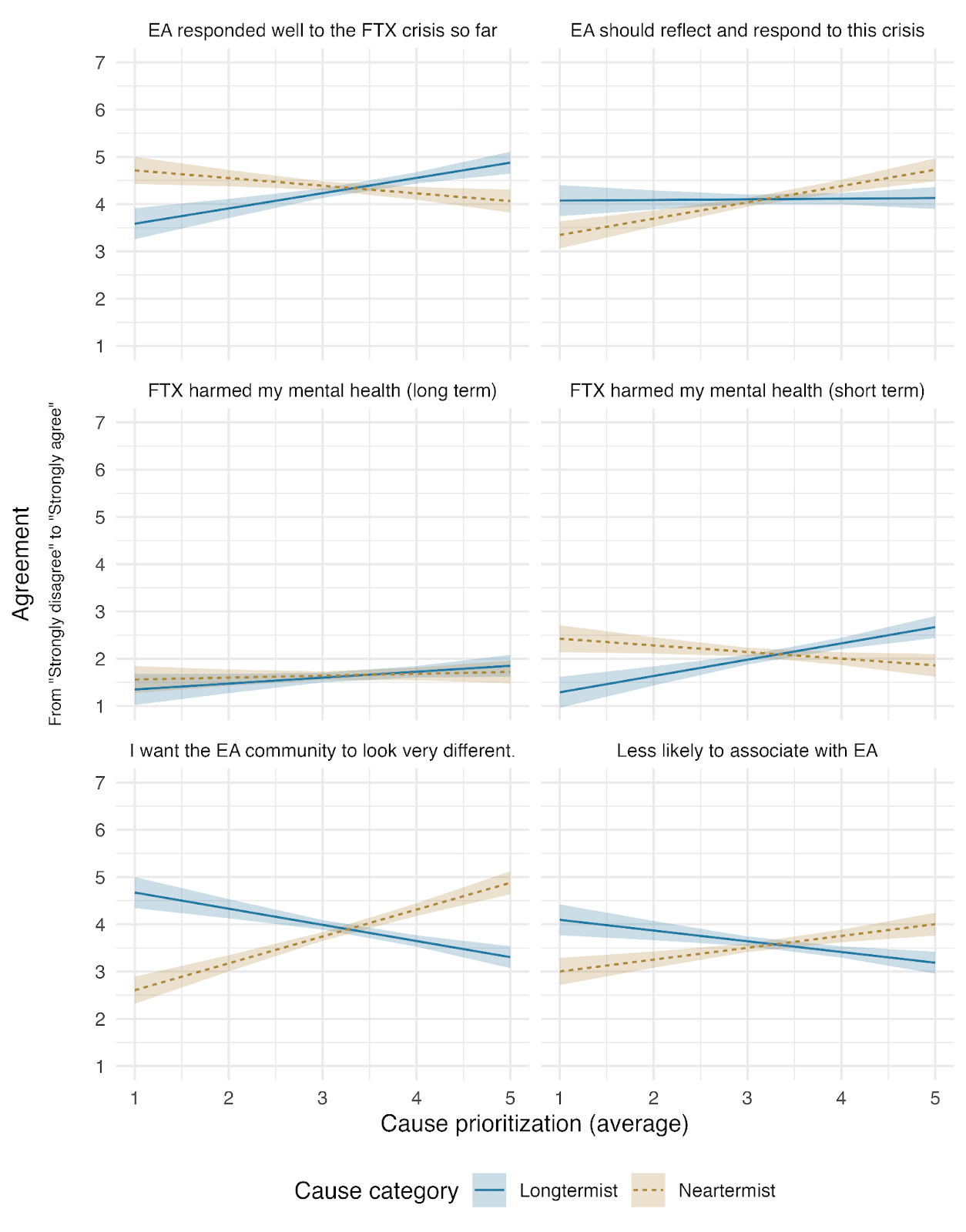
Engagement
There were also a few differences between respondents with different engagement levels and some of the questions. More engaged respondents agreed that FTX harmed their mental health more (although agreement levels are still rather low overall). Less engaged respondents agreed more that they want the EA community to look very different. No other differences were observed.
Gender
There are also several gender differences. Men slightly agreed more that EA responded well to the crisis so far and agreed less that EA should reflect and respond to this crisis, that the EA community should look very different, and that the FTX crisis harmed their mental health. No differences were found for the association with EA question and long term mental health question.
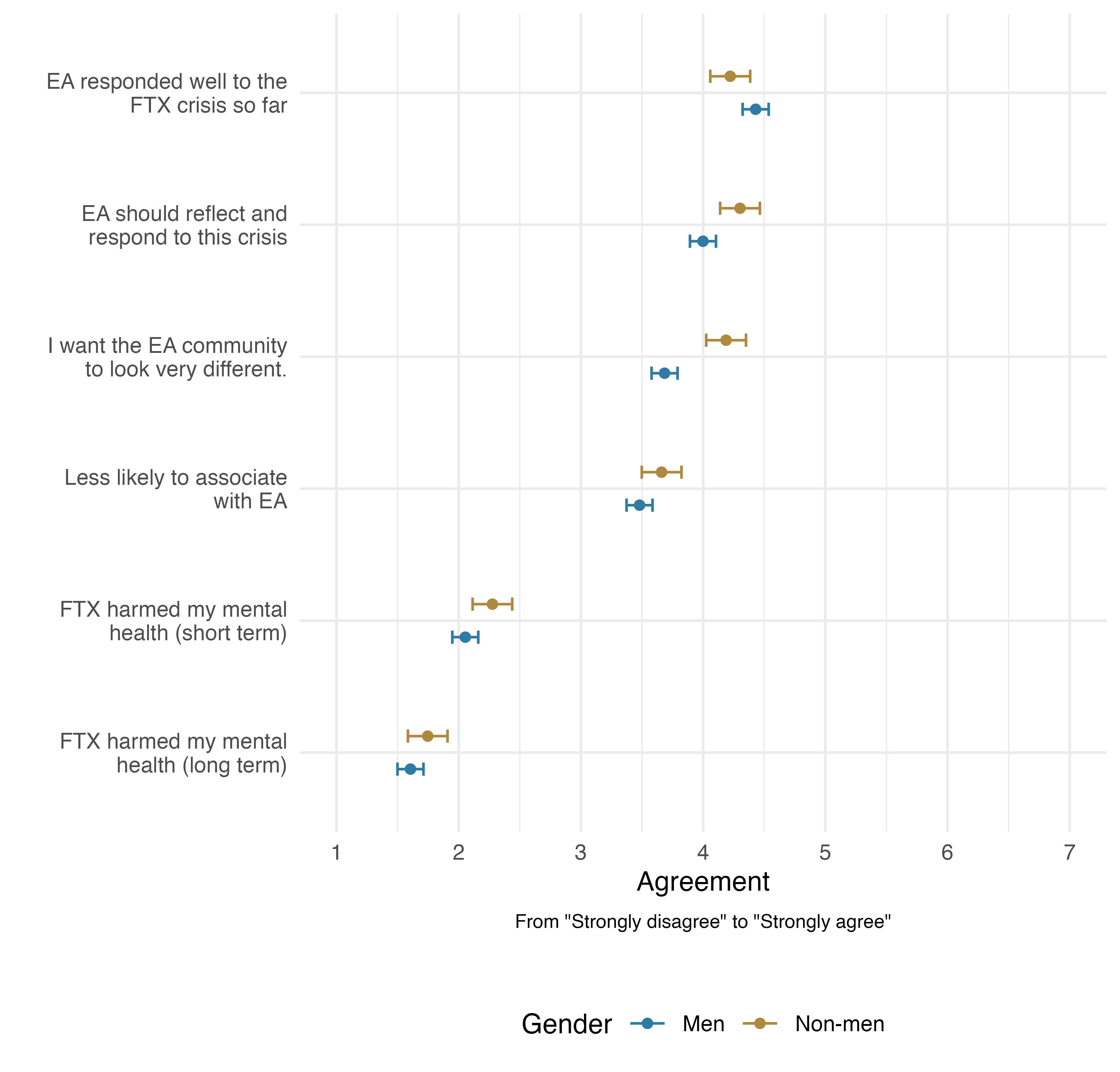
Race
Few differences were found between white and non-white respondents. Only one item showed a statistically significant difference. Non-white respondents agreed slightly more that the FTX crisis harmed their short term mental health.
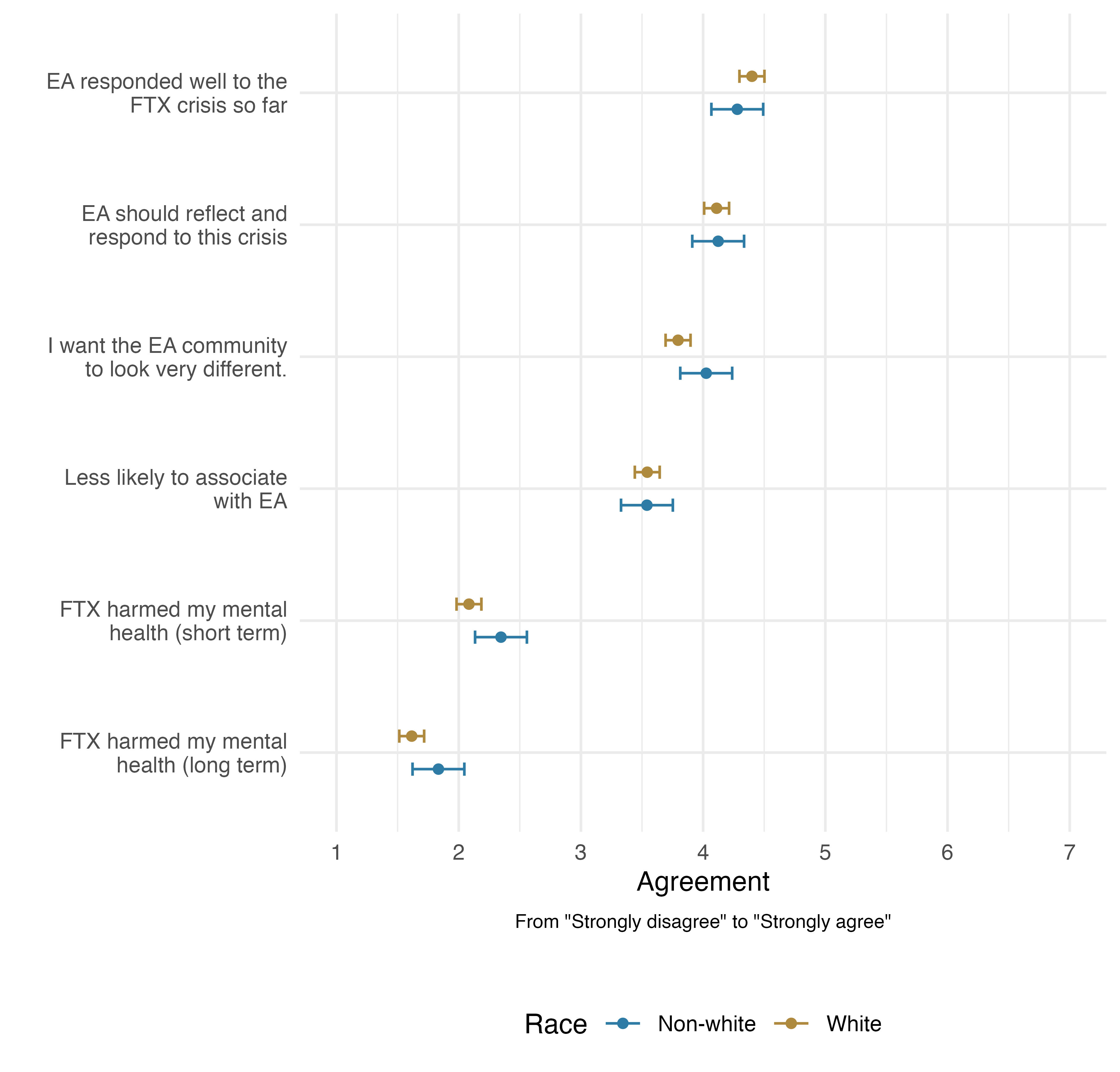
Trust in organizations
Cause prioritization
Trust levels did not covary with the degree to which respondents prioritized neartermist causes. It did seem to covary with the degree to which they prioritized longtermist causes, with greater longterm causes prioritization being associated with more trust in each organization, although this was not statistically significant for CEA.
Engagement
Regarding engagement levels, it seems that OP is trusted more by more engaged respondents, while for CEA and 80K it looks like the relationship is curvilinear. More engagement with the EA community is associated with more trust but highly engaged respondents seem to trust CEA and 80K less.
Gender
Men trust 80K and OP more than non-men. The difference was not statistically significant for CEA.
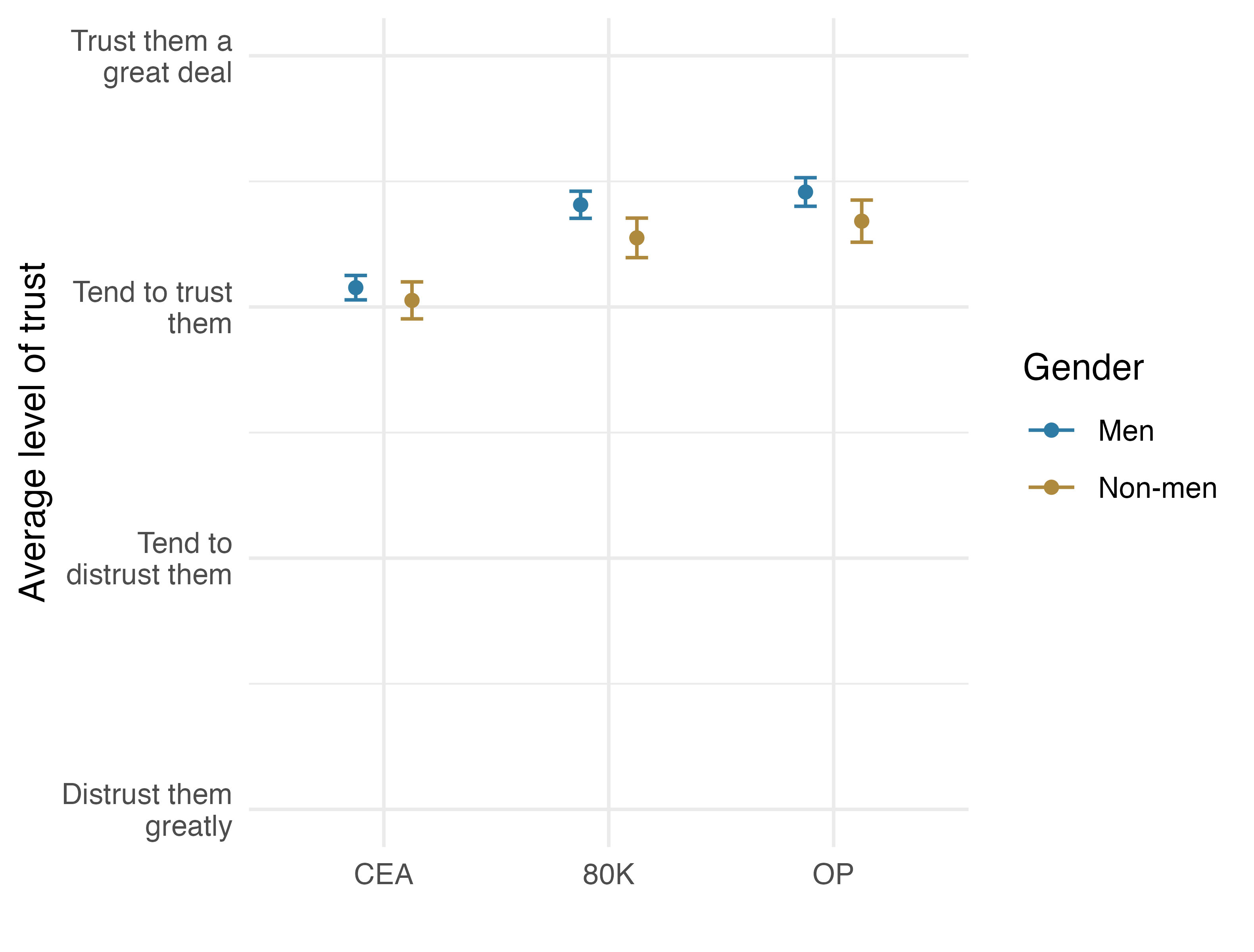
The annual EA Survey is a project of Rethink Priorities. The FTX Community Response questions were added in collaboration with the Centre for Effective Altruism. This post was written by David Moss and Willem Sleegers, with qualitative analysis contributed by Conor McGurk. Thanks to everyone who took and shared the survey.
If you like our work, please consider subscribing to our newsletter. You can see more of our work here.
- ^
The survey questions were added as an extra section to the 2022 EA Survey, with a separate survey link provided for respondents who had already completed the EA Survey. Both surveys were closed on 1st January 2023, so responses came in throughout a month-long period in December 2022 (the FTX news broke over a 10 day period in early November).
3567 respondents completed the EAS survey. Of these, 1012 EAS respondents were willing to answer the FTX section of questions and 300 respondents completed the separate FTX survey, resulting in an overall sample size of 1312 for the FTX-related questions.
- ^
Of course, it is an open question to what extent our sample reflects the community as a whole. It is plausible that people who were were more negatively affected by the FTX crisis might be more motivated to respond to the survey, which might skew responses in a negative direction, but it is also possible that respondents who were more negatively affected by the crisis might be less motivated to take the survey or more likely to leave the community entirely. As always, the EA Survey likely recruits disproportionately more highly engaged EAs and fewer less engaged EAs, so the overall results primarily reflect responses from people who are moderately or highly engaged in the EA community.
- ^
These categories were collapsed due to the very low number of respondents in the ‘non-binary’ and ‘prefer to self-describe’ categories. Although there may be differences between how these categories respond compared to ‘women’, and compared to each other, the small numbers would not allow a meaningful comparison. In addition, a number of EA diversity/community-building efforts have focused on ‘women and non-binary’ individuals as a category, so this seems like a meaningful practical category.
- ^
For simplicity, we label support for these, non-longtermist, causes “neartermist”, as we have in previous years. However, it’s worth noting explicitly that there is little reason to suppose that neartermism specifically, (e.g., attitudes or beliefs related to helping present vs. future generations or different time preference) explain support for these causes, rather than different epistemic beliefs (e.g., about appropriate kinds of evidence) or support for more traditional causes etc.
- ^
As with gender, and as in previous years, we combined respondents who selected a category other than ‘white’ into a single category due to the low number of respondents in each category.

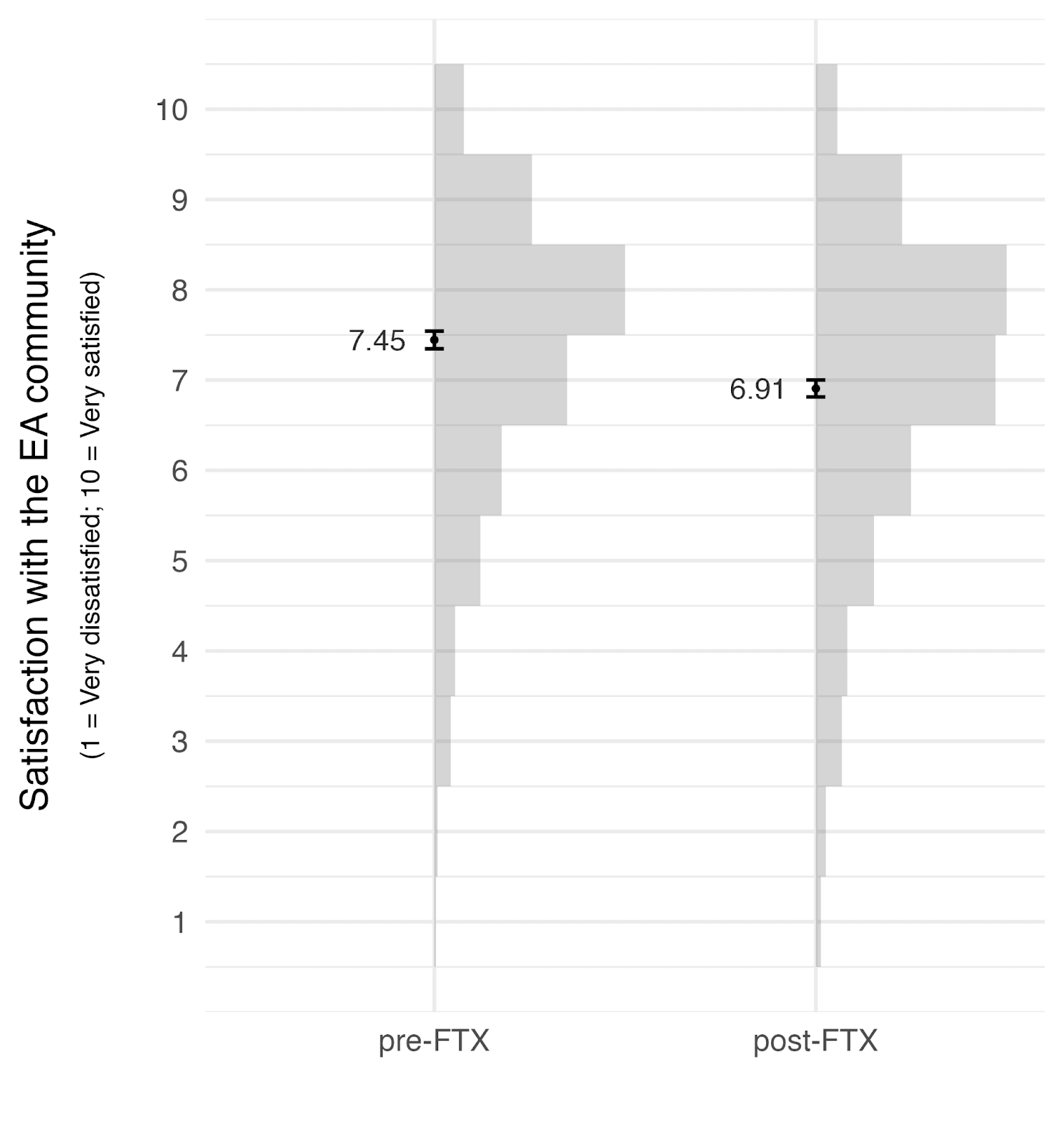
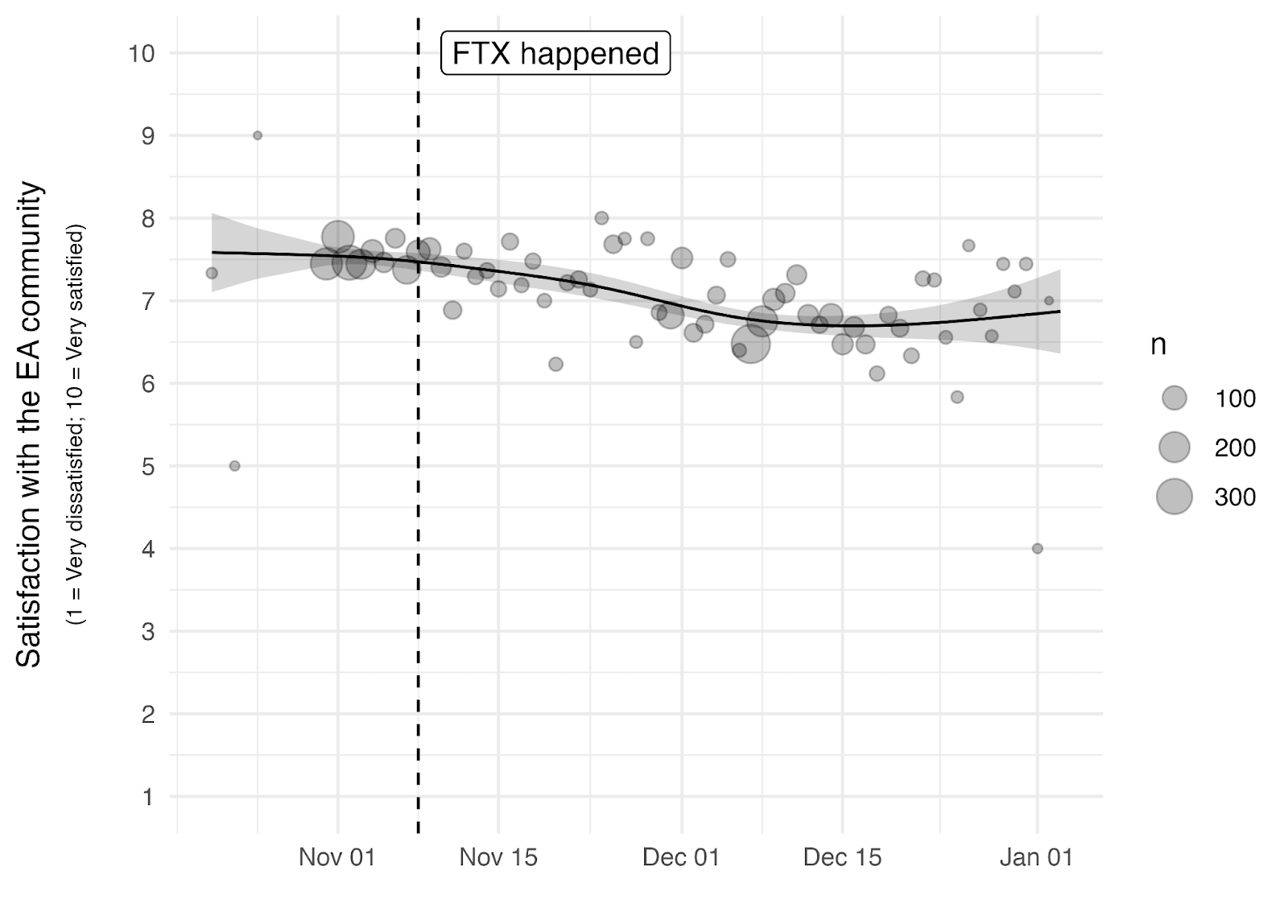
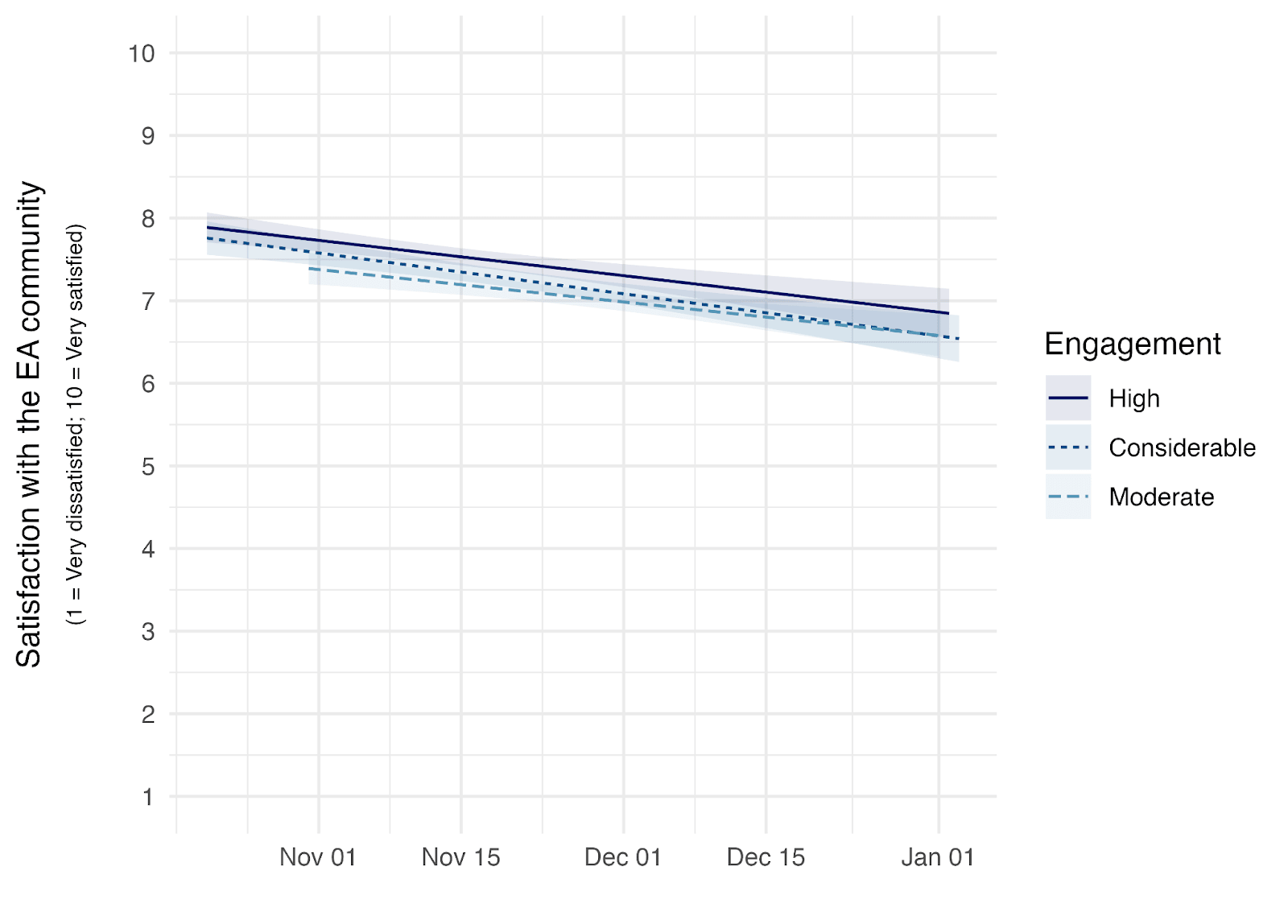
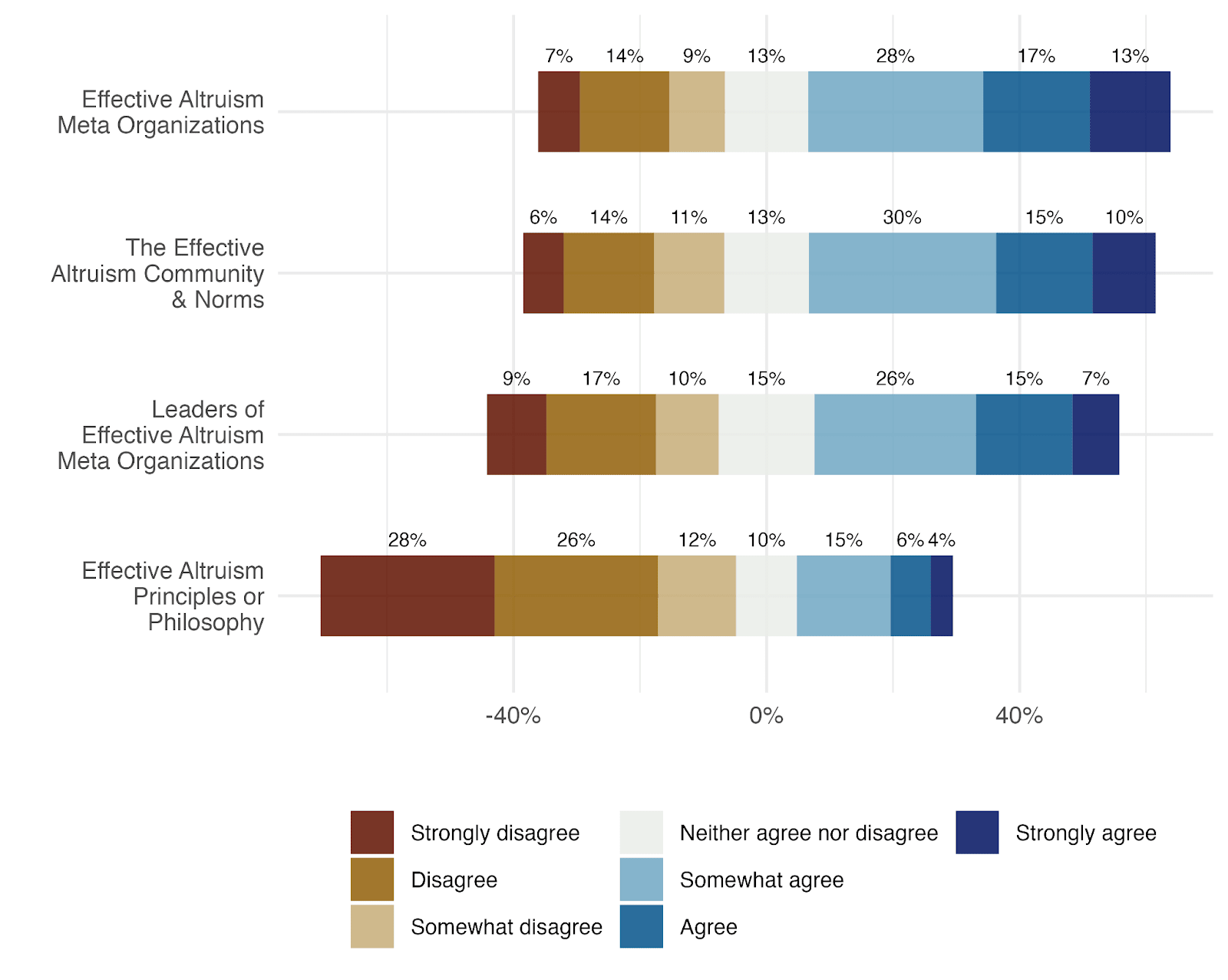
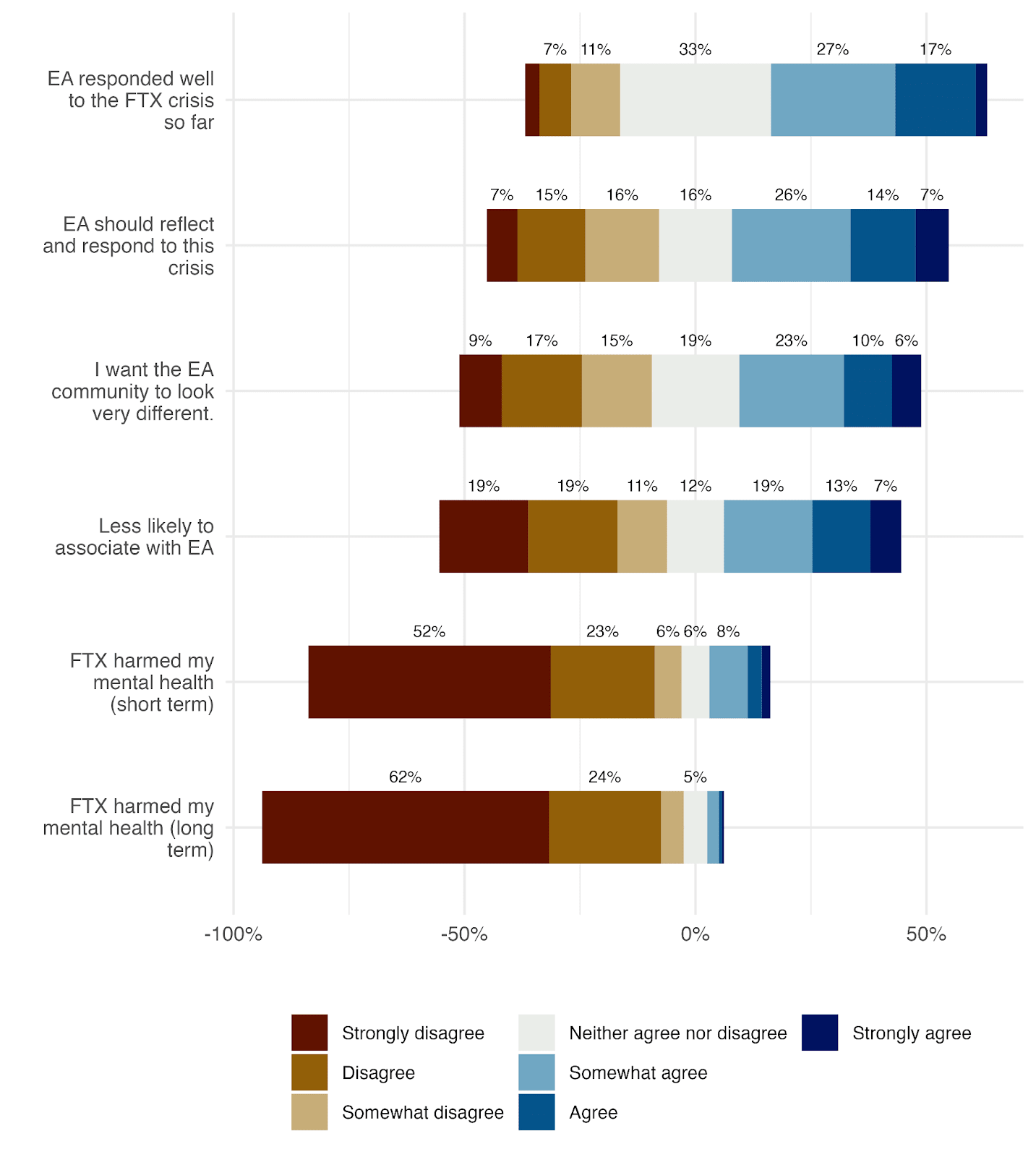
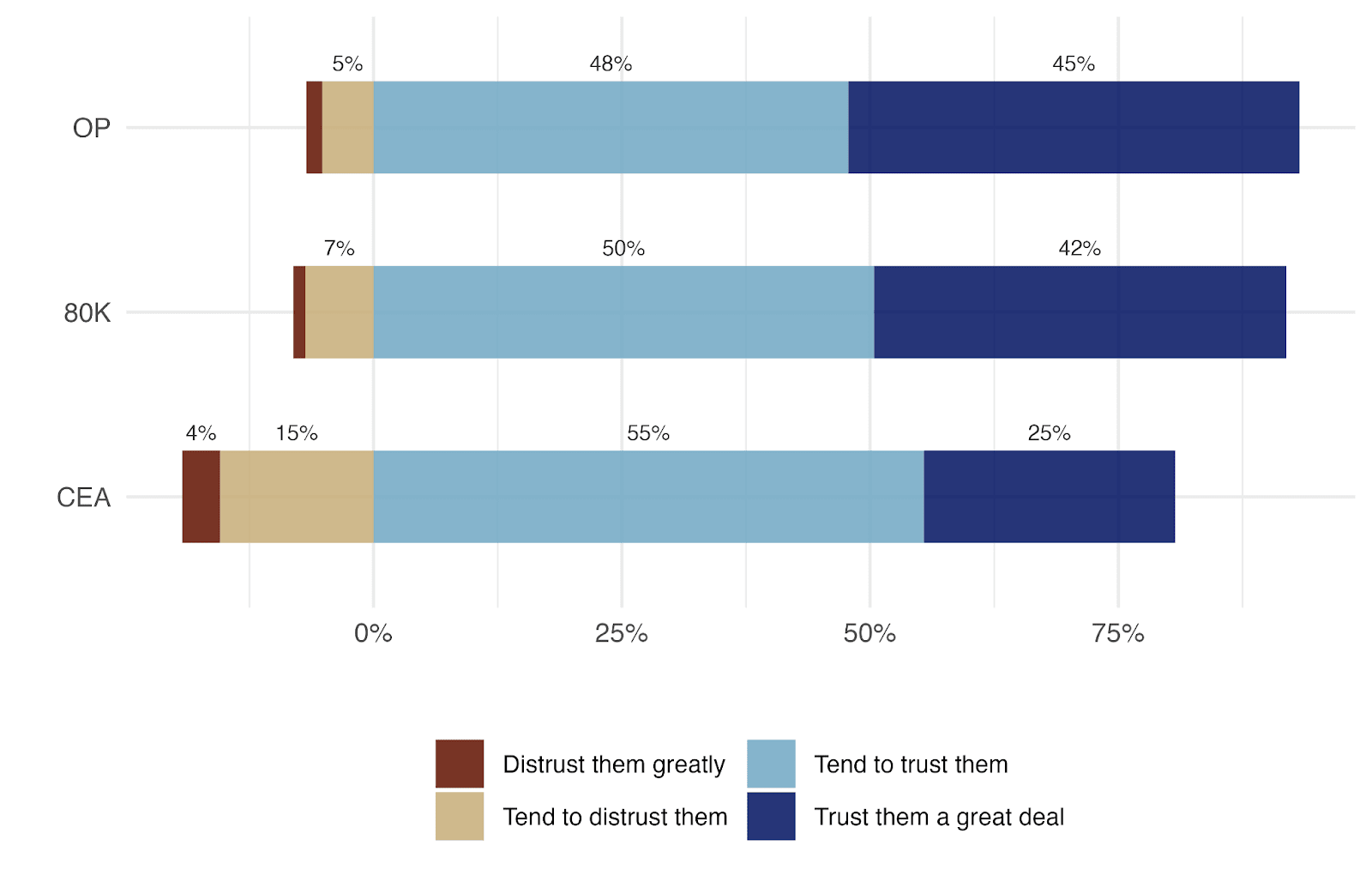
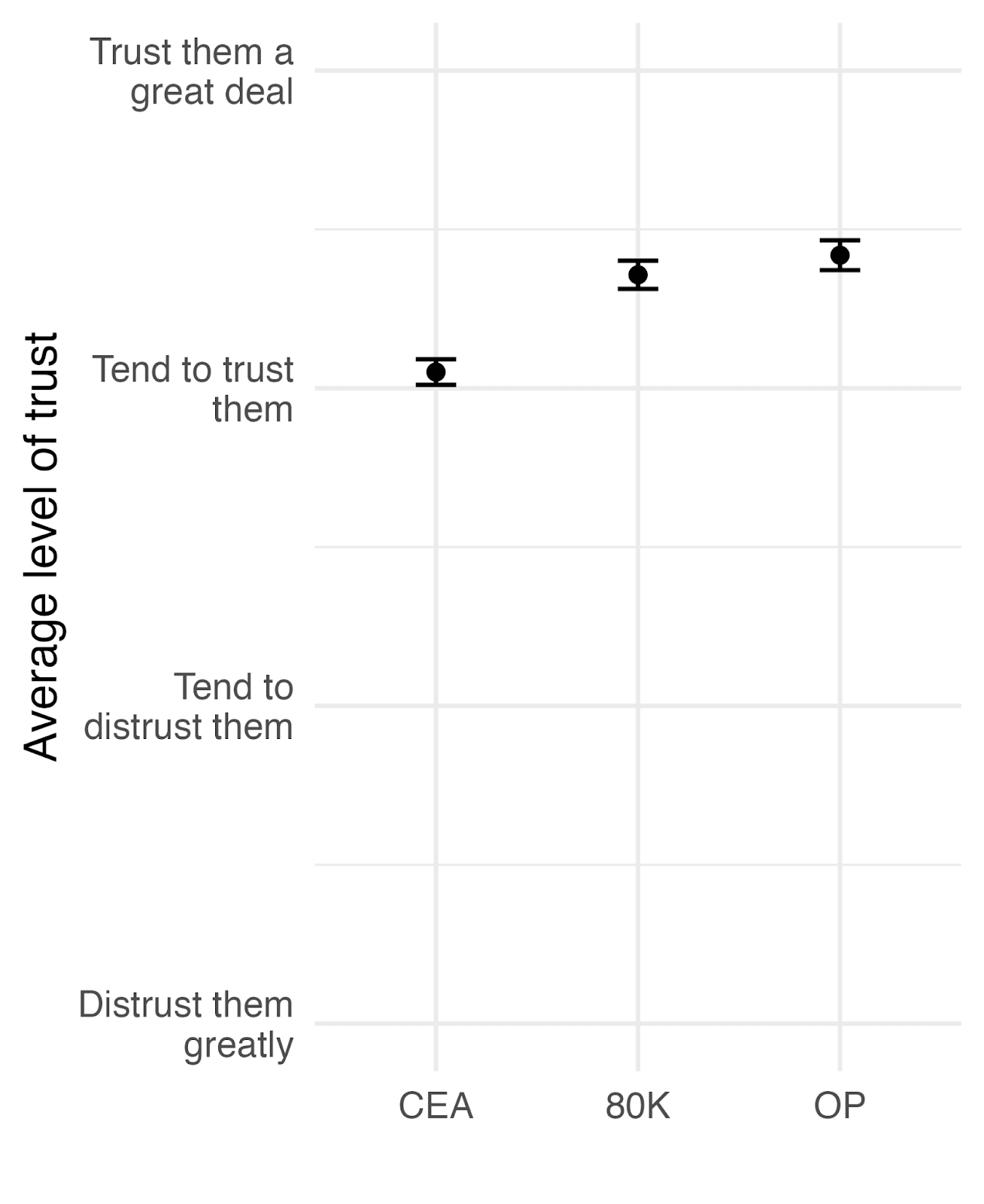
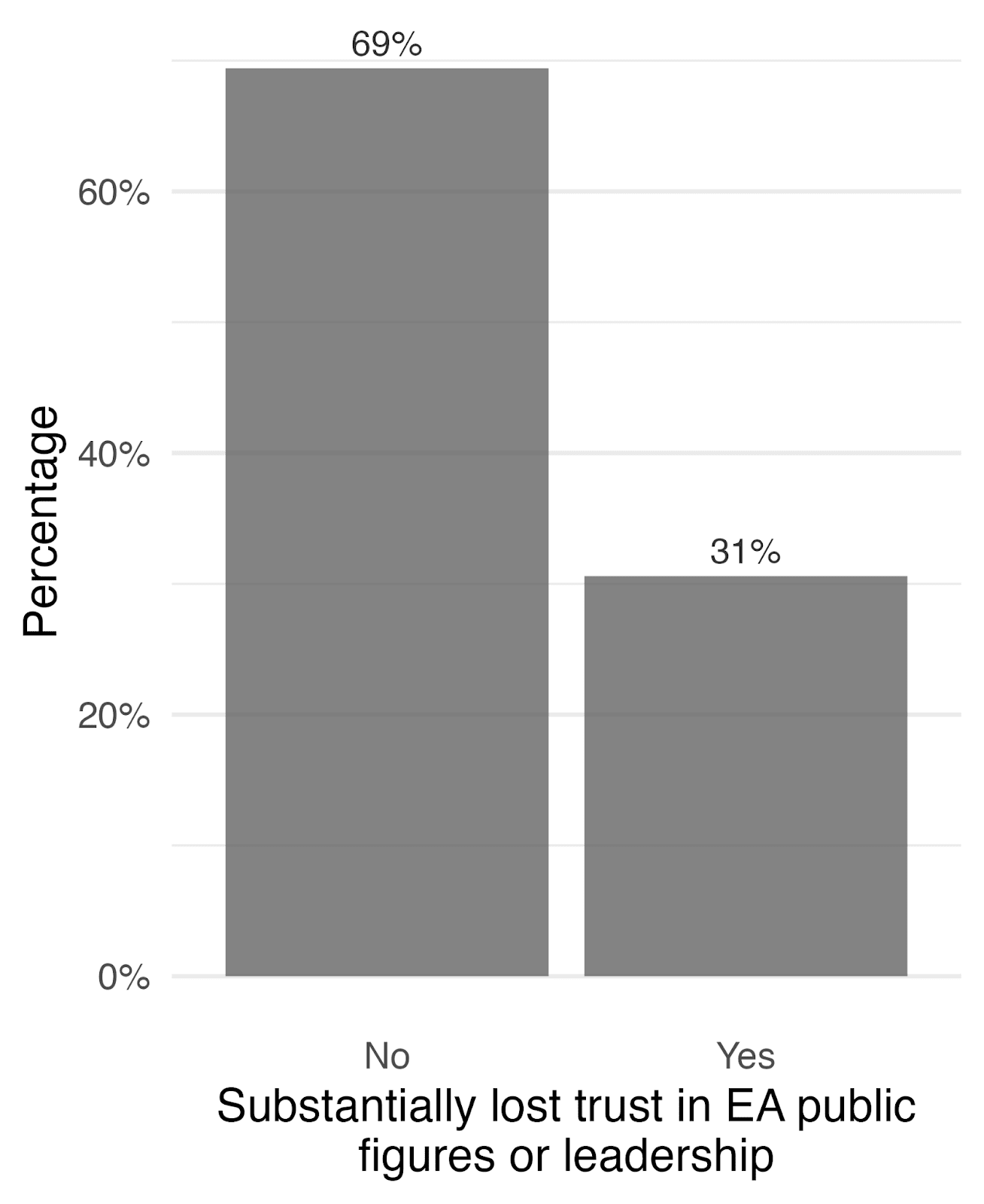
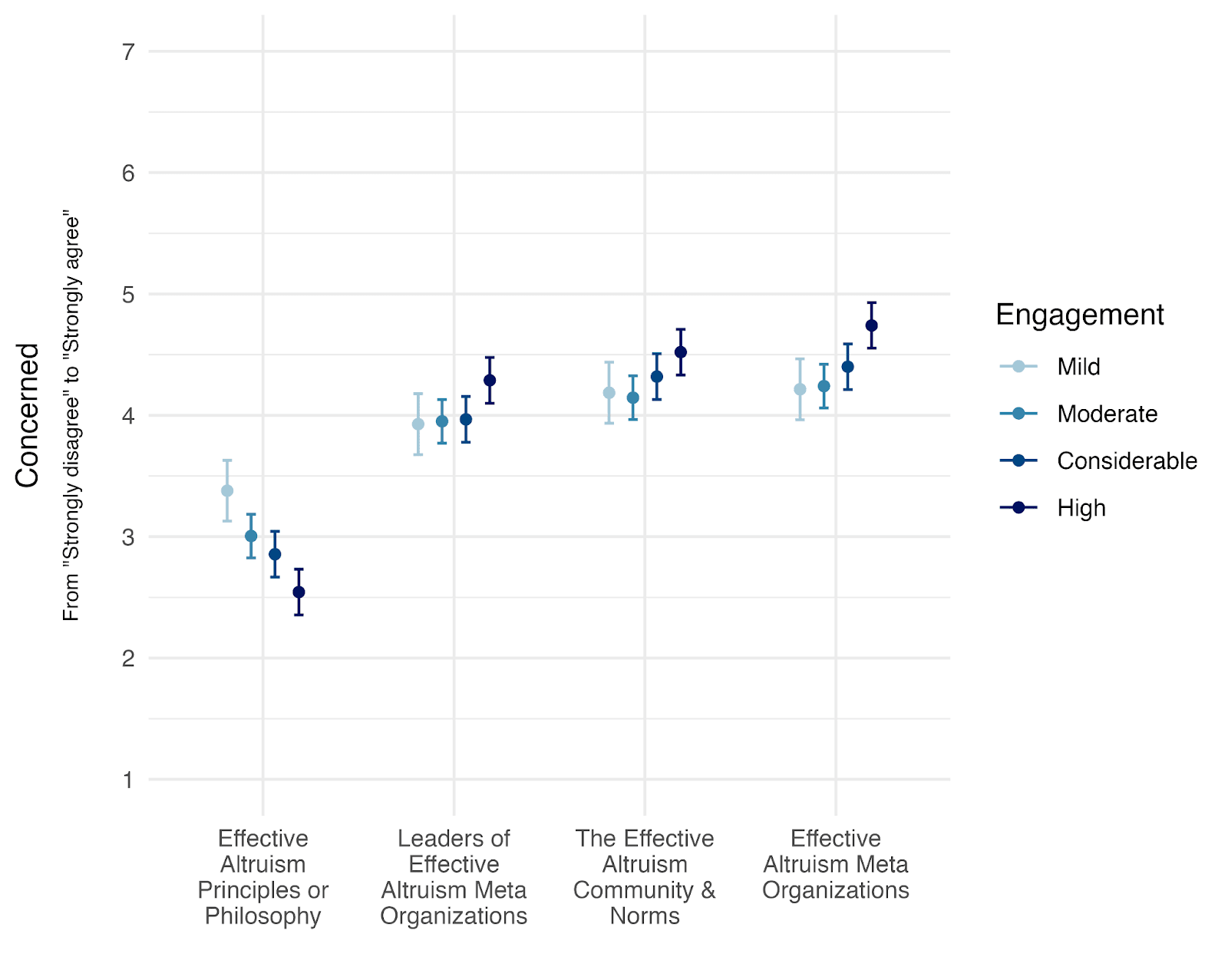
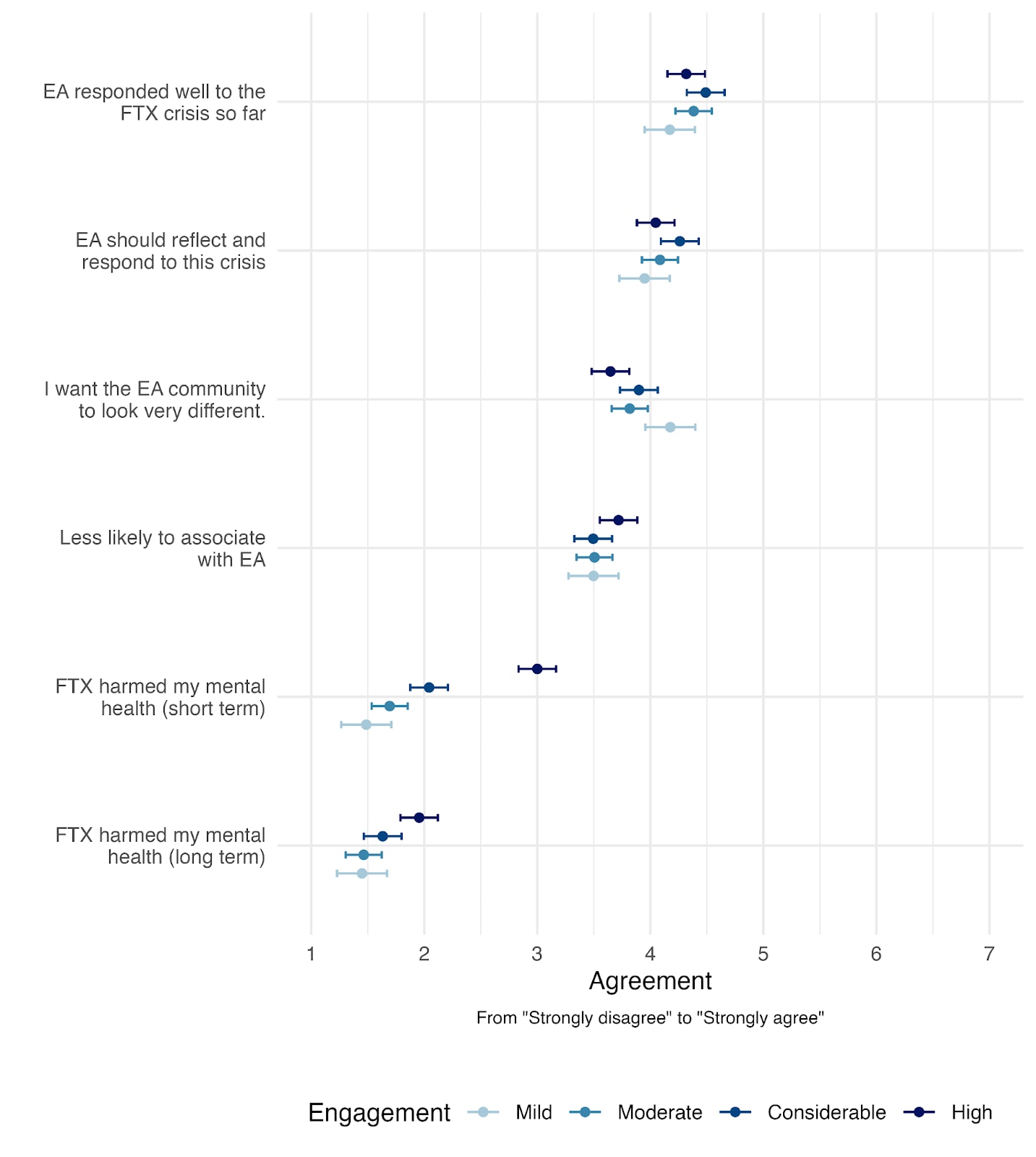
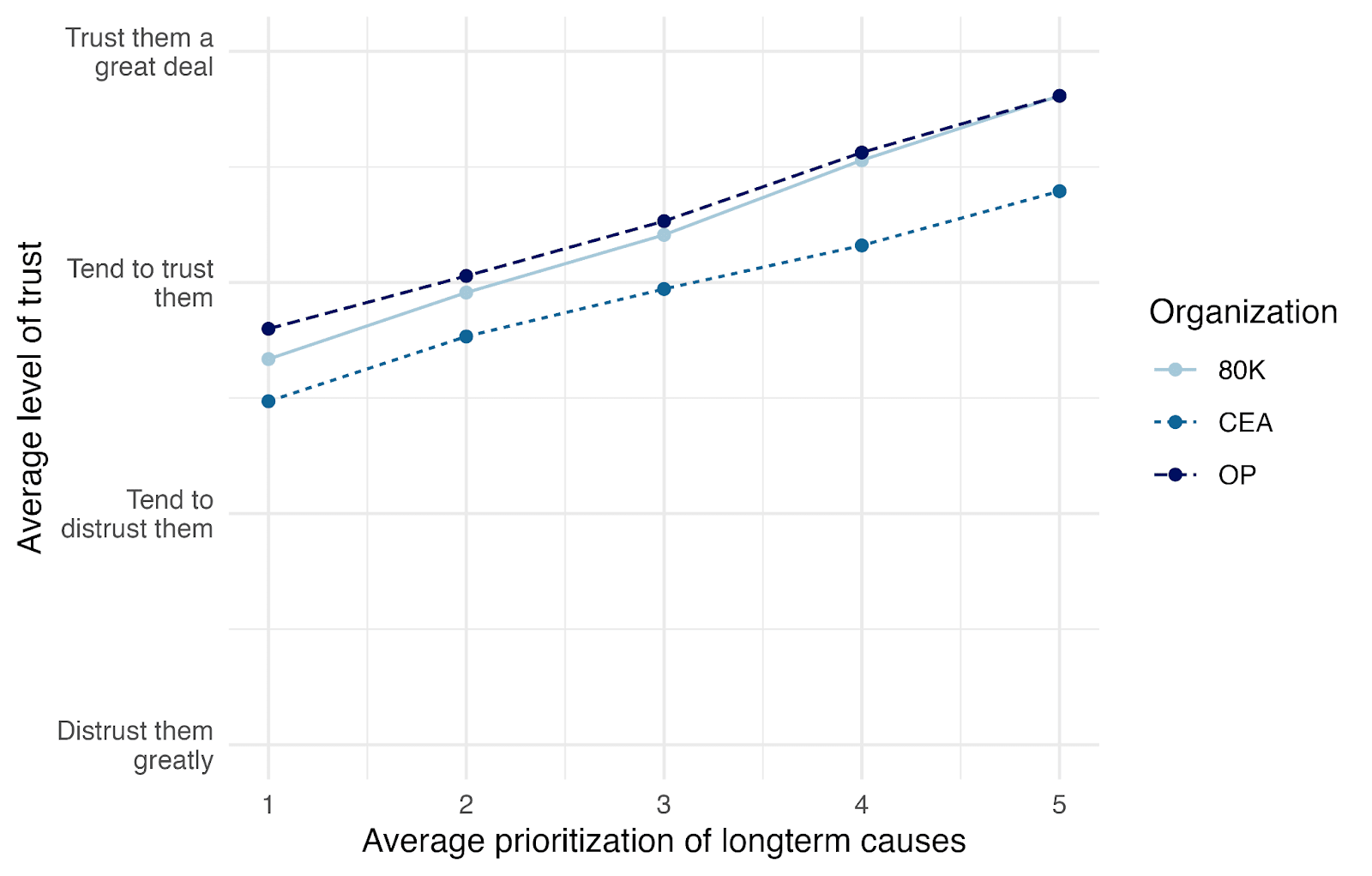
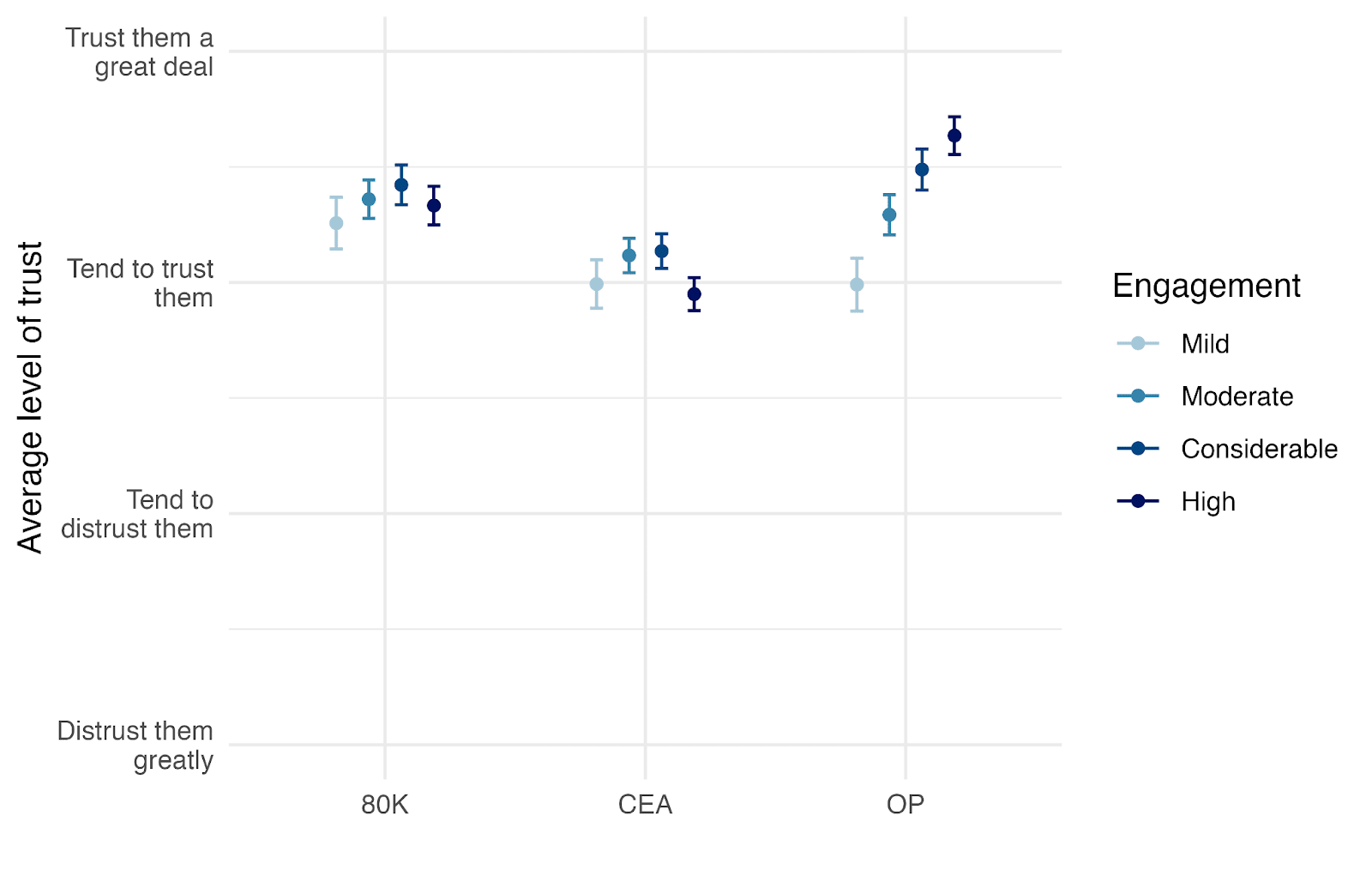

I'd expect this to look significantly worse if done in March rather than Dec :(
Might it be possible to re-survey a subset of people just about overall satisfaction, to see if it's moved?
Yes, we are planning a followup survey (most likely in 2-3 months). We have consent to send approximately 1600 respondents a followup survey (and may do additional parallel recruiting).
That's great!
Yeah, I also feel this way. Doing a bit of resurveying seems like it could be quite valuable.
I might have missed this but can you say how many people took the survey, and how many people filled out the FTX section?
Yes we can! And admittedly that should have been in there already. I've added the numbers to Footnote 1, which now has an extra sentence reading: "3567 respondents completed the EAS survey. Of these, 1012 EAS respondents were willing to answer the FTX section of questions and 300 respondents completed the separate FTX survey, resulting in an overall sample size of 1312 for the FTX-related questions."
Do you have any data you can share on how the population responding to the FTX section/survey differs from the full EAS survey population? E.g. along dimensions like EA engagement, demographics, ... – Or anything else that could shed light on the potential selection effect at this stage? (Sorry if you say this somewhere and I missed it.) Thanks for all your work on this!
Yes we do (and thanks for the comment!).
First, 80.1% of respondents who were asked to answer additional questions about FTX decided to do so. This is similar to the number of respondents (83.1%) who agreed to answer the ‘extra credit’ questions prior to us adding the FTX questions. So, it does not seem like there was a large tendency for respondents to not answer the FTX questions, compared to just a general tendency to not answer extra questions at all.
Second, we looked at whether there are differences in demographics between those who answered the FTX questions and extra credit questions (prior to FTX). We found that men were slightly less likely to answer the extra credit questions (81.8% for men and 85.7% for non-men) but more likely to answer the FTX questions than non-men (81.9% for men and 76.3% for non-men).
We also find that more engaged respondents are more likely to answer the additional questions (no surprise there).
Looking at cause prioritization, we found that higher ratings of longtermist causes and higher ratings of neartermist causes were associated with being less likely to answer this section. So, these do not seem to show a distinctive effect of longtermism or neartermism. This could simply be explained by a third factor or reflect an association with general ‘cause positivity’ (e.g. people who generally tend to rate all causes more highly are less likely to answer these questions).
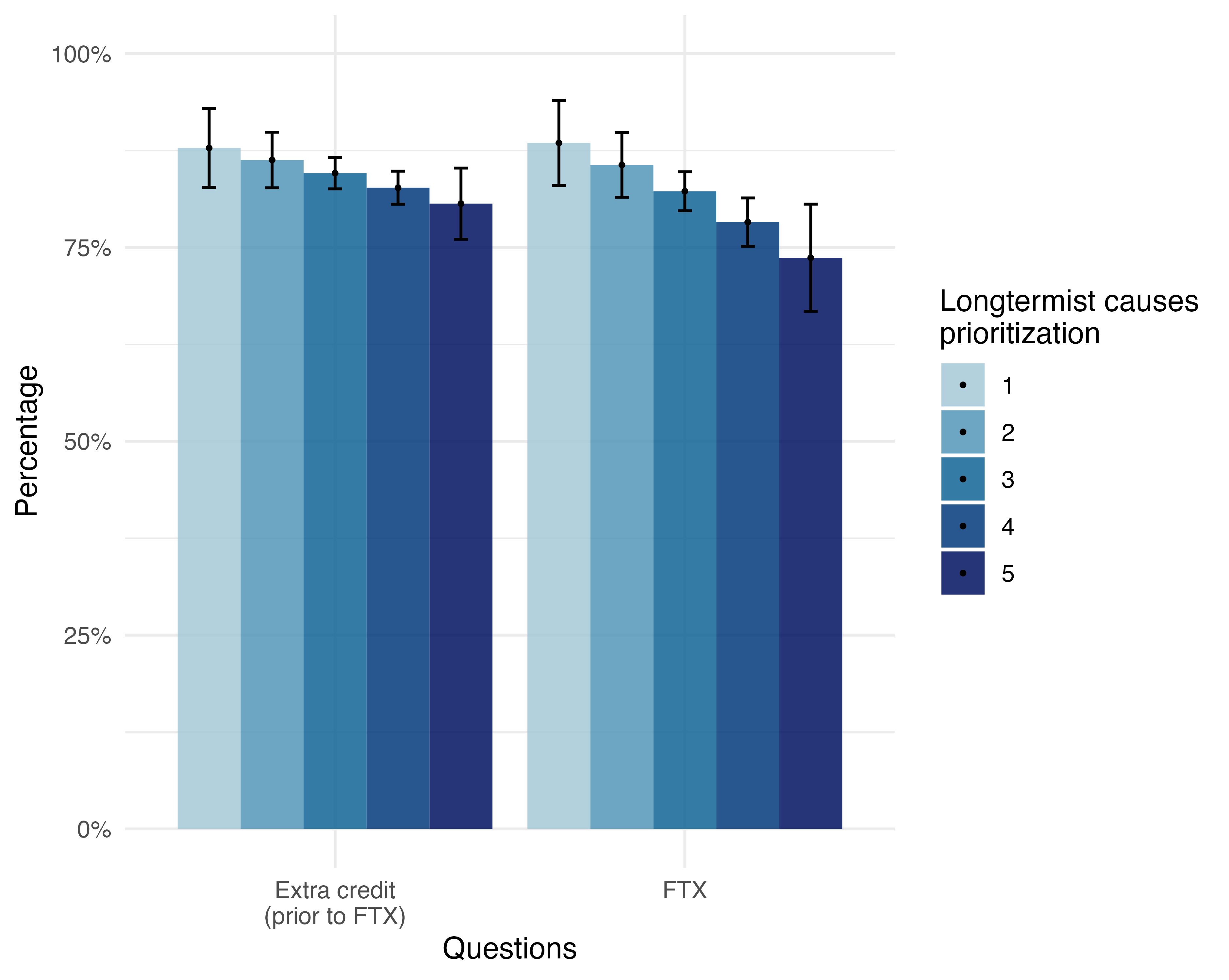
We conducted a further analysis based on a cluster analysis which we had conducted previously (and which we will outline in the forthcoming cause priortization post). This groups respondents into three discrete groups: longtermists, neartermists, and a group which rates both cause areas highly (this group is disproportionately newer EAs). In this analysis there was no significant difference in likelihood to answer these questions, but people in the ‘high everything’ cluster were substantially less likely to answer these questions.
We did not find any statistically significant differences regarding race (White vs. Non-white) and age.
Thanks, appreciate it!
Pretty striking that "those who prioritize neartermist causes more reported being more concerned across all questions"
Also that mildly EA-engaged people more agreed the community should look very different in response to the FTX crisis, while more EA-engaged people more disagreed
Suggests community will shift away from 'big tent' effective altruism and towards a more longtermist and hardcore community if it avoids reform?
Also more male, by that argument, given
Good point, I missed that
I'm not really sure if the data suggests this.
The question is rather vague, making it difficult to determine the direction of the desired change. It seems to suggest that longtermists and more engaged individuals are less likely to support large changes in the community in general. But both groups might, on average, agree that change should go in the 'big tent' direction.
Although there are statistically significant differences in responses to "I want the community to look very different" between those with mild vs. high engagement, their average responses are still quite similar (around 4.2/7 vs. 3.7/7). Finding statistically significant differences in beliefs between two groups doesn't always imply that there are large or meaningful differences in the content of their actual beliefs. I feel I could also just be overlooking something here.
Any thoughts on how the FTX crisis affected who responded to the survey and the results through this? I can imagine people leaving EA because of FTX and so not responding as a result, but others (and maybe even people not close to the movement) might respond specifically to express their dissatisfaction with EA and might not have responded otherwise.
I agree. We had already included this in our second footnote.
Thank you for doing this work and for the easy-to-read visualisations!
Thanks!
Sorry what does "cause prioritisation (average) mean here? I feel like I expect one line from 1 to 5 not 2 lines?
Thanks Nathan. The blue line represents higher ratings of longtermist causes (left to right) and the yellow line represents higher ratings of neartermist causes (left to right).
So, you can see that higher prioritization of longtermist causes is associated with lower ratings of concern (the blue line decreases left-right) and higher prioritization of neartermist causes is associated with higher ratings of concern (the yellow line increases left to right).
This approach has some advantages over just showing a single 'longtermism vs neartermism score' (even though that would be simpler). Although you might imagine that average support for longtermist and neartermist causes would simply be mirror images of each other and both have the same association with concern related to FTX, theoretically there's no reason this has to be the case. For example, it could be that there's a relationship between support for longtermist causes and concerns related to FTX, but not support for neartermist causes.
We'll discuss the relationship between the different dimensions more in the dedicated cause prioritization post of the series. (And, to be clear, I think there are some cases where it makes sense to use a single longtermism-vs-neartermism score; we've used both approaches before e.g. here and here).
I also found these charts a little confusing. A single value for each or a clustered column chart might be clearer
Thanks for the additional comment.
If it helps, you can simply look at the relationship between longtermism (left) and neartermism (right) separately, and ignore the other.
I think it is relatively safe in this instance to look at the relationship with mean longtermism-minus-neartermism scores (shown below), but only because we first examined the individual relationships (shown above) above since- as I noted in my reply to Nathan- support for longtermist causes and neartermist causes don't reflect a single dimension.
Is it possible to compare overall satisfaction to previous EA surveys? As you say, all the methods for extracting the impact of FTX from this data seem a bit suspect. Satisfaction now vs. satisfaction 1-2 years ago is simpler and arguably more decision-relevant.
It certainly is! (That said, I don't think comparing 2020 to 2022 is necessarily simpler. If we want to know where we are now, we presumably want to distinguish pre-FTX and post-FTX responses. And, if we want to know the effect of FTX, we may want to control for engagement, like in our other analyses, to account for differences between groups).
This plot shows the raw mean satisfaction for EAS 2020, EAS 2022, and for EAS 2022 (but only post-FTX).
However, if we control for engagement, and distinguish 2022 pre-FTX and post-FTX, we see that satisfaction actually seemed to be slightly higher in 2022 pre-FTX, before falling below 2020 levels post-FTX. (All differences significant.)
This is also what we see if we plot satisfaction across time for 2020 and 2022. 2022 appears to start out higher than 2022, before falling lower.
Thank, that's very helpful!
(I'm not surprised satisfaction was higher in 2022 than 2020 before FTX.)
FYI, I’ve just released a post which offers significantly more empirical data on how FTX has impacted EA. FTX’s collapse seems to mark a clear and sizable deterioration across a variety of different EA metrics.
Caveat: I work for Rethink Priorities, as do the authors of this post
Great to have this timely research and good antidote to some of the gloomy outlooks on how this has affected the community!
I especially liked the two convergent approaches for measuring the effect of the FTX crisis on EA satisfaction. I noticed in the satisfaction over time analysis, you can kind of eyeball a (slight) negative pre-trend. This made me wonder how you thought about the causal inference concerns both in that specific analysis and for this report generally? By extension, I wonder if the summary could be a bit more explicit:
Maybe this should read something like "FTX crisis was associated with, and may have caused, decreased satisfaction"?
Yeah it’s fair to worry about the causal interpretation of the satisfaction results, although I think the pre-trend you mention is mostly a result of the GAM model pulling the regression line down a bit due to the later observations. Limiting the analysis to the period before, say, November 9th, shows no such pre-trend. I’m personally more worried about possible confounds such as the one we note about engagement. It could also be that the FTX crisis motivated a certain group of people to take the survey and share their dissatisfaction. So, it’s true that the design of the survey does not lend itself to easily answer questions of causality, leaving it a matter of interpretation based on the results as a whole and context.
Regarding the overall interpretation, I think it might still be fair to conclude that the FTX crisis has decreased satisfaction if we take into account the other results, including the recalled satisfaction pre and before the FTX crisis and the explicit reports of concerns related to FTX, decreased trust etc.
Thanks, Willem, that all makes sense! I agree, the overall conclusion certainly seems fair, especially given the convergent evidence you cite.
Why is gender separated into "men" and "non-men"? I find it very weird but I guess there is a reason. Is something like "men", "women", "other" not optimal for any reason? If so, is there a reason to keep "men" instead of "women"?
See footnote 3.
Thanks!
Thank you for this work. I think it is interesting and valuable. Is any data on how external perspectives being collected on how public awareness and sentiment towards EA and related organisations has changed? This seems valuable to track.
Thanks Peter!
We do have some survey data looking at this, from a couple of different projects, some looking at the general US population and some looking at more elite populations. Some of this is commissioned private work though, so I'm not sure if/when we'd be able to publish the details.
However, the general findings suggested by these surveys were that:
Naturally with more work and larger samples we could provide more information with more confidence about this.